This article was about rooms for workers, their definition, development, importance for the labor market and the economy, types, advantages and disadvantages for tenants and landlords, legal regulations, contractual conditions and liability issues as well as tips for employees and landlords.
In summary, the most important points can be presented as follows:
- Fitter rooms are furnished rooms or apartments that are mainly used by employees who work temporarily outside of their place of residence.
- Fitter rooms have a long history and are closely linked to the development of the world of work and mobility.
- Rooms for workers are important for the labor market and the economy, as they offer workers affordable accommodation, thereby increasing the flexibility and mobility of workers.
- There are different types of fitter rooms, from simple rooms to high-quality apartments.
- Benefits of rooms for workers are cost-effectiveness, flexibility when booking and the opportunity to socialize with other workers. Disadvantages can be noise, lack of privacy or a poor living environment.
- Landlords of fitter rooms should ensure that the rooms are adequately equipped and safe, are priced fairly and competitively, maintain clear communication with guests and conclude transparent rental agreements.
- When looking for a room for workers, employees should pay attention to the location, amenities, prices and ratings.
In summary, worker rooms offer workers a flexible, inexpensive and often social housing option, while renters of worker rooms have an opportunity to generate additional income. However, both tenants and landlords should ensure that they comply with the legal regulations and agree on fair contractual terms in order to avoid legal conflicts.
